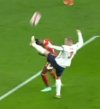Playing devil's advocate, a player PIADM must therefore 'endanger the safety of an opponent' and must therefore be sent off!Its when someone plays in a dangerous manner
I get it, but most could be forgiven for having no clue. Further twisting of words could include 'disregard to danger' or 'excessive force' to differentiate between yellow and red, but 'acts without precaution' doesn't really fit, so a caution seems necessary at a minimum. And it has to be bereft of contact to fit the definition
Typical of the book IMO. A load of nonsense. Which is probably why we very rarely (if ever) see IDFK's for PIADM
We're left with flimsy and barely decipherable definitions, yet we blame players for not knowing the Laws

So I've expanded upon your 'its when someone plays in a dangerous manner' reply (which was lacking somewhat
 )
)
Last edited:



